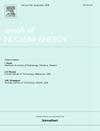专门用于核加热测量的新型差示量热计的设计和校准
IF 1.9
3区 工程技术
Q1 NUCLEAR SCIENCE & TECHNOLOGY
引用次数: 0
摘要
核加热速率是材料辐照实验设计的关键参数。为高通量工程试验堆(HFETR)设计并测试了一种新型移动式差热计(CAMORE)。采用蒙特卡罗模拟和三维计算流体力学进行结构和热设计,并选择不锈钢作为样品材料以获得最佳精度。CAMORE内部设置了一个高达30瓦的内部电加热组件来模拟核加热。所制备的量热计在实验室进行了性能测试,热响应灵敏度达到35.57°C·g·W - 1 (@ 3 W·g−1),符合安全温度约束。利用电加热得到的校准曲线,样品与参比池的差异小于2%,与模拟结果吻合较好,证实了该方法测量反应堆内核加热速率的适用性。本文章由计算机程序翻译,如有差异,请以英文原文为准。
The design and calibration of a new differential calorimetric dedicated to nuclear heating measurements
Nuclear heating rates are key parameters for the design of materials irradiation experiments. A novel mobile differential calorimeter (CAMORE) has been designed and tested for the High Flux Engineering Test Reactor (HFETR). Monte Carlo simulations and 3D Computational Fluid Dynamics are used for structural and thermal design, and stainless steel was chosen as the sample material to have best precision. An inner electrical heating assembly up to 30 W is set inside the CAMORE to simulate the nuclear heating. The performance of the manufactured calorimeter have been tested in lab, the thermal response sensitivity of 35.57°C·g·W–1 (@ 3 W·g−1) have been achieved, and adhering to safety temperature constraints. The calibration curves are obtained using the electrical heating, the difference between the sample and reference cell is less than 2 %, which are well agreed with simulations, confirming the suitability for measuring nuclear heating rates within the reactor.
求助全文
通过发布文献求助,成功后即可免费获取论文全文。
去求助
来源期刊

Annals of Nuclear Energy
工程技术-核科学技术
CiteScore
4.30
自引率
21.10%
发文量
632
审稿时长
7.3 months
期刊介绍:
Annals of Nuclear Energy provides an international medium for the communication of original research, ideas and developments in all areas of the field of nuclear energy science and technology. Its scope embraces nuclear fuel reserves, fuel cycles and cost, materials, processing, system and component technology (fission only), design and optimization, direct conversion of nuclear energy sources, environmental control, reactor physics, heat transfer and fluid dynamics, structural analysis, fuel management, future developments, nuclear fuel and safety, nuclear aerosol, neutron physics, computer technology (both software and hardware), risk assessment, radioactive waste disposal and reactor thermal hydraulics. Papers submitted to Annals need to demonstrate a clear link to nuclear power generation/nuclear engineering. Papers which deal with pure nuclear physics, pure health physics, imaging, or attenuation and shielding properties of concretes and various geological materials are not within the scope of the journal. Also, papers that deal with policy or economics are not within the scope of the journal.
 求助内容:
求助内容: 应助结果提醒方式:
应助结果提醒方式:


